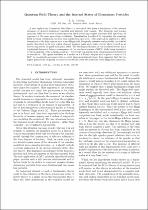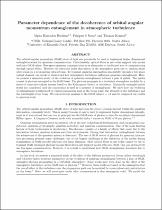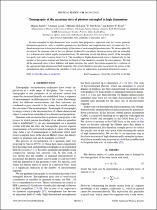JavaScript is disabled for your browser. Some features of this site may not work without it.
- ResearchSpace
- →
- Archives collection
- →
- Open Access Reports
- →
- View Item
| dc.contributor.author |
Greben, JM

|
|
| dc.date.accessioned | 2011-09-23T13:17:44Z | |
| dc.date.available | 2011-09-23T13:17:44Z | |
| dc.date.issued | 2011 | |
| dc.identifier.citation | Greben, JM. 2011. Quantum field theory and the internal states of elementary particles. pp. 24 | en_US |
| dc.identifier.uri | http://hdl.handle.net/10204/5176 | |
| dc.description.abstract | A new application of quantum field theory is developed that gives a description of the internal dynamics of dressed elementary particles and predicts their masses. The fermionic and bosonic quantum fields are treated as interdependent fields satisfying coupled quantum field equations, all expressed at the same space-time coordinate. Quantization is realized by expanding the quantum fields in terms of fermionic creation and annihilation operators. This approach is applied in a QCD description of the light quarks with a zero Higgs field. Originally massless and pointlike, an isolated quark (described in its own center-of-mass) acquires mass and a finite extent when treated as an interacting system of quark and gluon fields. The binding mechanism of this localized system has a topological character, being a consequence of the non-linear nature of QCD, while being insensitive to the magnitude of the coupling constant. To prevent this system from collapsing general relativity is introduced. The quark stabilizes at a radius of 8.8 Planck lengths and acquires a mass of 3.2 MeV, in remarkable agreement with accepted phenomenological values. It is suggested that the two higher generations of quarks are associated with the other two solutions of the Higgs field equations | en_US |
| dc.language.iso | en | en_US |
| dc.relation.ispartofseries | Workflow;7245 | |
| dc.subject | Quantum field theory | en_US |
| dc.subject | Quantum fields | en_US |
| dc.subject | Elementary particles | en_US |
| dc.subject | Fermionic quantum fields | en_US |
| dc.subject | Bosonic quantum fields | en_US |
| dc.title | Quantum field theory and the internal states of elementary particles | en_US |
| dc.type | Report | en_US |
| dc.identifier.apacitation | Greben, J. (2011). <i>Quantum field theory and the internal states of elementary particles</i> (Workflow;7245). Retrieved from http://hdl.handle.net/10204/5176 | en_ZA |
| dc.identifier.chicagocitation | Greben, JM <i>Quantum field theory and the internal states of elementary particles.</i> Workflow;7245. 2011. http://hdl.handle.net/10204/5176 | en_ZA |
| dc.identifier.vancouvercitation | Greben J. Quantum field theory and the internal states of elementary particles. 2011 [cited yyyy month dd]. Available from: http://hdl.handle.net/10204/5176 | en_ZA |
| dc.identifier.ris | TY - Report AU - Greben, JM AB - A new application of quantum field theory is developed that gives a description of the internal dynamics of dressed elementary particles and predicts their masses. The fermionic and bosonic quantum fields are treated as interdependent fields satisfying coupled quantum field equations, all expressed at the same space-time coordinate. Quantization is realized by expanding the quantum fields in terms of fermionic creation and annihilation operators. This approach is applied in a QCD description of the light quarks with a zero Higgs field. Originally massless and pointlike, an isolated quark (described in its own center-of-mass) acquires mass and a finite extent when treated as an interacting system of quark and gluon fields. The binding mechanism of this localized system has a topological character, being a consequence of the non-linear nature of QCD, while being insensitive to the magnitude of the coupling constant. To prevent this system from collapsing general relativity is introduced. The quark stabilizes at a radius of 8.8 Planck lengths and acquires a mass of 3.2 MeV, in remarkable agreement with accepted phenomenological values. It is suggested that the two higher generations of quarks are associated with the other two solutions of the Higgs field equations DA - 2011 DB - ResearchSpace DP - CSIR KW - Quantum field theory KW - Quantum fields KW - Elementary particles KW - Fermionic quantum fields KW - Bosonic quantum fields LK - https://researchspace.csir.co.za PY - 2011 T1 - Quantum field theory and the internal states of elementary particles TI - Quantum field theory and the internal states of elementary particles UR - http://hdl.handle.net/10204/5176 ER - | en_ZA |









